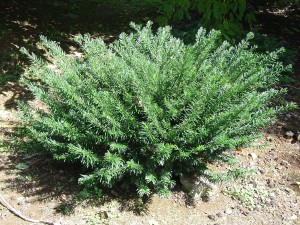Plum yews (Cephalotaxus harringtonia) are evergreen needle conifers which flourish in the heat and humidity of the Southeastern U.S. (USDA hardiness zones 6-9). Likely, the groundcover forms are hardier to zone 5-b if protected by snow cover or surrounding vegetation from dry winter winds.
Plum yews are native to China, Korea and Japan. Many people confuse them with Japanese yews (Taxus spp.) which grow poorly in southern clay soils and are highly susceptible to deer feeding. Plum yews are highly deer resistant*.
Plum yews start out growing slowly, but catch up once established in 2 years or less. Lustrous dark green evergreen needles vary in length from ¾ to almost 2 inches. Foliage retains its lush green color through the winter months.
Plum yews substitute for Japanese yews (Taxus spp.)in the south. Available cultivars vary in plant height and growth form. Plum yews cope with either light shade or full sun. They prefer a moist well drained soil, but established plants exhibit good drought tolerance.
There are 3 distinct growth forms of plum yew:
‘Fastigiata’ is a columnar form that grows 10 feet tall and 6-8 feet wide in 15-20 years.
‘Prostrata’ and ‘Drupacea’ grow 2 ft tall and 20 plus feet wide. Clip off aberrant shoots that spring up to maintain a uniform groundcover appearance.
‘Duke Gardens‘) has a semi-upright, spreading shrub appearance similar to spreading forms of Japanese yews (Taxus x media) or (T. cuspidata). It was found at Sarah P. Duke Gardens in Durham, N.C. as a chimera (mutation) on ’Fastigiata‘.
* Deer resistance is based on “normal” population numbers. Deer will feed on most plants if their populations are exceptional high or when natural food resources become depleted.


 Posted in
Posted in 
